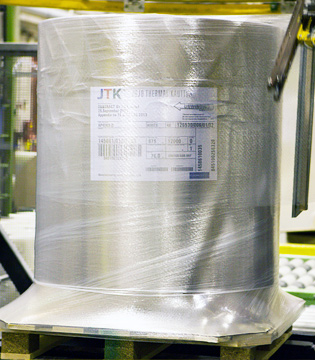Avoid exposure to direct sunlight and hot and humid environments
All papers will turn yellow with time, especially if exposed to direct sunlight for prolonged periods.
- For long-term storage, all papers should be kept in the dark at an average ambient temperature of less than 25⁰c and relative humidity of less than 65%.
Additional instructions for thermal papers
If you are searching for a thermal paper grade for an application where there is a risk of contact with harmful materials or for an application where excellent preservability properties are required, please contact our customer service for assistance in selecting the most suitable paper from our range of durable and extra-durable grades.
- JTK thermal papers begin to develop colour at temperatures between 60⁰C and 100⁰C and reach an applicable density at 70–120⁰C, depending on the grade. The paper, however, displays similar signs of development at high temperature or in conditions of high humidity. If the paper is used continuously for more than 24 hours at temperatures of 40⁰C or above, attention should be paid to the ambient temperature and humidity.
- The printed image tends to fade in direct sunlight.
- The image shows a tendency to fade when exposed to conventional fluorescent light for prolonged periods of time. Printed paper should therefore be filed soon after printing.
Do not use solvent-type adhesives
- Adhesives containing volatile organic solvents, such as alcohols, esters, ketones etc., cause colour formation.
- Adhesives based on starch, PVA or CMC are harmless and are therefore recommended.
Avoid contact with plasticizers
- PVC film contains plasticizer, such as ester phthalate. Prolonged contact with such films reduces the image-forming property of thermal paper and causes fading of the printed image. For storing thermal papers, we recommend files and cases made of polyolefins or polyester.
- Self-adhesive cellophane tapes might contain plasticizers which cause the printed image to fade. We do not recommend tacking a double-sided self-adhesive tape on the reverse side of JTK thermal papers.
Others
- Avoid direct contact with freshly developed diazo copying paper as it might induce color forming on the surface of JTK thermal paper.
- Avoid direct contact with carbon as well as carbonless copying papers as these might reduce printability or cause the printed image of JTK thermal paper to fade.
- Human body fluids like sweat causes the printed image of JTK thermal paper to fade. Please pay attention to proper paper handling.
- JTK thermal paper sheets must be stored with their printed surface separate from each other because the printed image might slightly be transferred from one surface to the other.
- Frictional heat induced by scratching or pressure by hard metal objects, finger nails etc. causes images to be developed. Please pay attention to proper paper handling and avoid e.g. transportation of heavy jumbo rolls by rolling them on the floor.

